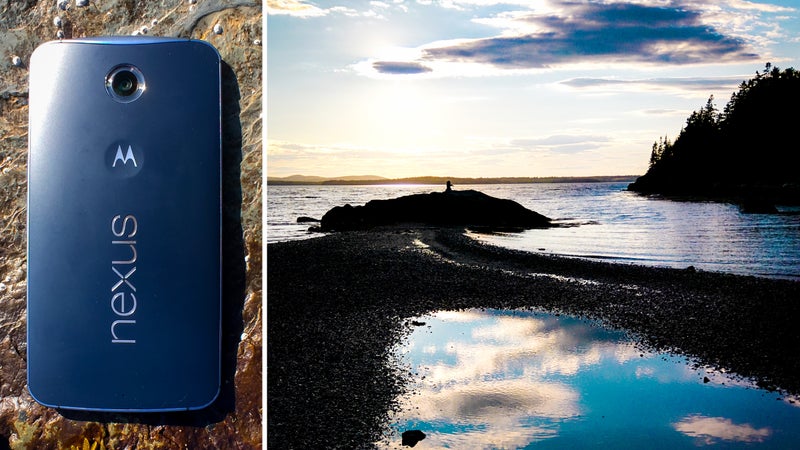A DSLR takes better photos than your cell phone, but it’s not nearly as convenient. As the saying goes, “The best camera is the one you have with you.”
Plus, cell phone cameras have gotten pretty damn good, to the point where you can produce 8-by-10 prints that look great in a frame.
To find out which cell phone camera you should buy, we gathered the top four competitors and put them to the test. We’ve listed our results below, but before we start, a couple quick notes.
First, this review does not touch on video, only stills. And second, remember that more megapixels do not always equal better photos. Some phones in this review have a lot of megapixels. Others have relatively few. But don’t judge a camera by its megapixel number. That’s because even though some cameras have fewer pixels, the pixels they have are bigger, which means they’re somewhat better at gathering light, leveling the playing field. Keep reading for a more granular look at which phone is best for you.
LG G4

What we like: The G4 has a great camera app with a manual mode that lets you adjust features like exposure compensation, ISO, shutter speed, and manual focus. If you want, you can shoot images in RAW format, which means the camera won’t compress the photo, making for easier editing and better clarity. The G4 also picked up very close-focus details in faces and nature, especially at low light.
What we don’t: The curved metal case makes the camera difficult to hold. The focus is a little slow compared to rivals, such as the Nexus 6, and some screen controls are difficult to read in full sunlight. Also, batteries in both the LG G4 and the Nexus 6 ran into the red after a whole day of shooting, while the iPhone and Samsung batteries held steady at 30 to 40 percent.
Best for: Photophiles who want pro-level controls.
iPhone 6

What we like: The iPhone 6 takes clear, crisp daylight photos that are comparable to any phone in this roundup. But the iPhone’s real advantage is iOS. Because this operating system is so popular, it has a broad and smart selection of third-party apps—everything from well-designed toning apps to Photoshop-caliber manipulation. All the native camera apps we tested shoot panoramas, but the iPhone’s pano function created the fewest visible fusion points from frame to frame across the image. We also really like the HDR function and shutter-hold-down function, which lets you reel off roughly five frames per second, which is great for capturing action shots. Pro tip: For the best photo quality, upgrade your iPhone’s lens with one from Moment.
What’s missing: The iPhone 6 is a great all-round option but struggles in low light, especially compared to the LG and Nexus. We were able to shoot clear enough starlit-night shots to share on social media with the G4 (using an awesome Anycase cell phone tripod mount), and depending on the circumstance, the Galaxy S6 Edge. But our iPhone shots were too noisy (that is, grainy).
Best for: Travel and adventure since it’s the smallest phone in the batch and has great battery life. Plus, there are a million durable cases to choose from so it doesn’t get ruined when it falls in the muck.
Google Nexus 6

What we like: The camera’s shutter is fast, making it good for action sports. It has an ultrabright LED screen and comes with well-designed image stabilization software that helps in low light, besting all the other cameras except the LG. The camera app is simple to use and effective when it comes to editing, but we prefer shooting with the third-party Camera FV-5 app because it lets you shoot RAW images and allows for extended control over the shutter and ISO. Like the Apple iPhone 6, the Nexus has an excellent HDR function.
What’s missing: We wish Google would give the camera app the functionality of an third-party app like FV-5, particularly when it comes to shooting RAW images. Also, this is a big phone, so it’s great for viewing images but bulky as hell.
Best for: Newbie shooters who want to up their photo game. It’s easy to use out of the gate, but it can also help you advance your skills thanks to a slick third-party app.
Samsung Galaxy S6 Edge

What we like: The native photo app on the S6 Edge gives you some manual control of things like ISO and focus. (You still need the Camera FV-5 app to shoot in RAW.) The battery life was just as good as the iPhone 6—and better than the other Android phones—and it was second only to the LG for crisp close-focus detail. The color saturation was also rich; film buffs will be reminded of Fujichrome.
What’s missing: In very low-light situations—say, a five-second manual exposure—shots can get noisier than those produced by the other Android phones here, although they’re still slightly better than the iPhone 6.
Best for: Anyone interested in the LG and wants similar qualities in a smaller package.

